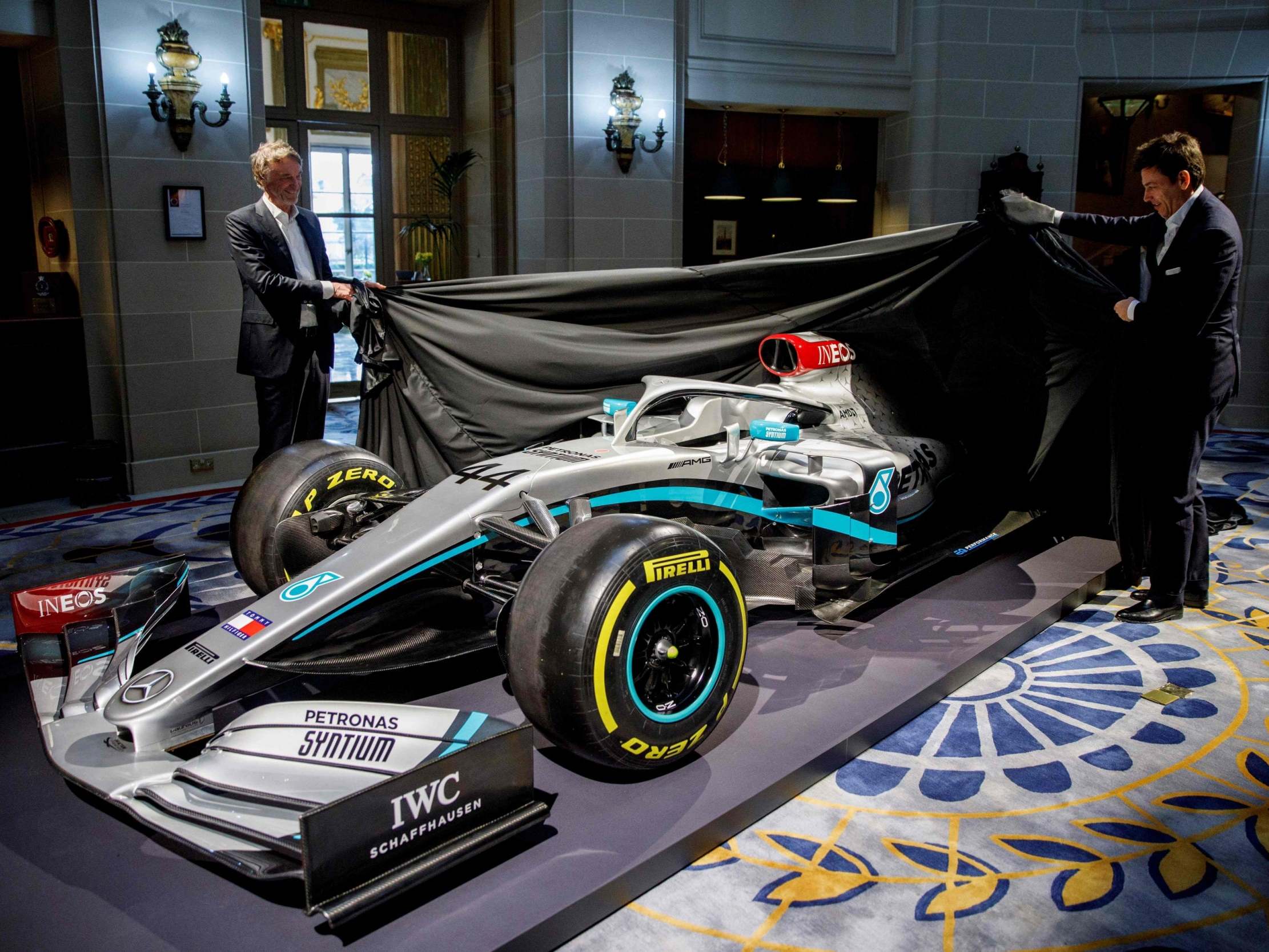What Ineos and Mercedes stand to gain from a curious new kind of sporting ‘partnership’
Jim Ratcliffe will have the name of his petrochemicals giant splashed across the fastest car in Formula One and will borrow expertise for his big sporting projects, but what Mercedes gain beyond hard cash is more vague

In the hallway of London’s Royal Automobile Club, two rich men peeled away a silk blanket to reveal the new Mercedes-AMG W11 F1 car. It looked much the same as the 2019 edition which Lewis Hamilton drove to his sixth world title, but added to the livery were a few splashes of burgundy red displaying an increasingly familiar name in the world of sport: the petrochemicals giant Ineos.
Moments earlier the two men, Mercedes’ team principal Toto Wolff and Ineos’s billionaire chairman Sir Jim Ratcliffe, had announced their new collaboration, and a sponsorship deal thought to be worth £100m over five years to the F1 team. Ineos already owns French football club Nice, Swiss side Lausanne-Sport, Tour de France champions Team Ineos, Ben Ainslie’s America’s Cup sailing team and was behind Eliud Kipchoge’s sub-two-hour marathon feat, and Ratcliffe can now add Formula One to his growing collection.
On the surface it might look like any other sponsorship deal, but the two parties were keen to stress something deeper. This is not a sponsorship but a “partnership”, the beginnings of which were first announced back in December. It is not an investment by one company in another but a mutually beneficial relationship summed up by vague business talk: a synergy, a meeting of minds, an ideas emporium.
The plan is to pool the expertise of Mercedes F1 engineers with Team Ineos’s cycling team and Team UK’s America’s Cup sailing project. Ineos seems to be getting the most obvious sporting benefits: a team of 18 Mercedes engineers have been deployed in Portsmouth for several months now working on the Ineos Team UK AC75 sailing boat to race in the America’s Cup, which Ratcliffe described as designing “a 10-storey building sailing on a coffee table”. Mercedes’ highly regarded aerodynamics expert Graham Miller moved full-time from his Brackley base to the south coast in order to commit to the project.
Of all Ratcliffe’s sporting triumphs, the America’s Cup is probably the most audacious, as he attempts to guide a British team to the oldest trophy in sport for the first time since 1851. As well as huge financial capital invested in the venture, thought to be upwards of £120m, there is also a significant chunk of pride riding on Sir Ben Ainslie’s fortunes in New Zealand’s Hauraki Gulf next March. There is some logic, then, to bringing in the technical expertise of the world’s foremost F1 team for a sailing race dubbed “Formula One on water” to strengthen Ainslie’s chances of making history.
Ratcliffe’s cycling arm, Team Ineos, have experienced minimal input so far from Mercedes, but both sides have mentioned the “interesting challenges” to be tackled around bike design. Mercedes are aiming to “optimise aerodynamic performance” of the frames carrying Geraint Thomas and Chris Froome over Alpine mountains, and the F1 team’s state-of-the-art wind tunnel in Silverstone could be opened up to Ineos for testing. Quite how much crossover there is between building Formula One cars and bicycles is unclear; perhaps pit-stop mechanics can teach Dave Brailsford’s team how to change a tyre in under two seconds.
Exactly what Mercedes stand to gain in a sporting sense is less obvious. The company has pointed to the benefits of a more holistic approach in which their engineers gather experience working in different fields, and the hope is for some broader benefits; the launch of their Mercedes-Benz Applied Science (MBAS) arm alongside the Ineos partnership is not specifically targeted at any one facet of Hamilton’s race car, but has a wider mission to be at the forefront of sporting engineering, to innovate.
A cynic might suggest Ineos’s main contribution to the ‘partnership’ is hard cash. In return, just as much as the engineering expertise on offer, Ratcliffe and Ineos have been seduced by an association with the fastest team in Formula One, and by the opportunity for the red logo to adorn Hamilton’s car and by extension F1 race tracks around the world. “Twenty years ago a Mercedes was a taxi, an old person’s car,” said Ratcliffe. “I would never have bought a Mercedes, but today it’s a very different image. Winning six championships in a row has changed Mercedes’ image.”
After the car’s unveiling, Ratcliffe insisted there were no current plans to further expand his sporting network, which he described as “sufficient”. Time will tell whether the new partnership between a German F1 team and a British petrochemicals company will be little more than another sponsorship deal or will break new sporting ground. This remains one of Ratcliffe’s primary motivations: whether it is proving the possibility of a sub-two-hour marathon or conquering the notoriously difficult America’s Cup, he wants Ineos to leave its mark on the sporting world, and is prepared to go to expensive lengths to get there.
Join our commenting forum
Join thought-provoking conversations, follow other Independent readers and see their replies
Comments
Bookmark popover
Removed from bookmarks